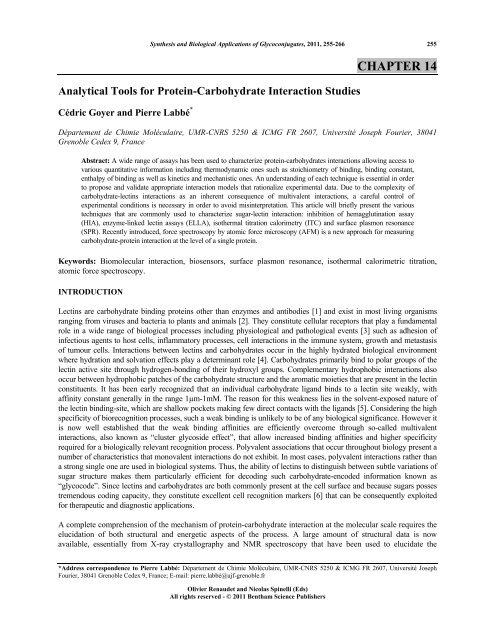chapter 2 - Bentham Science
chapter 2 - Bentham Science
chapter 2 - Bentham Science
Create successful ePaper yourself
Turn your PDF publications into a flip-book with our unique Google optimized e-Paper software.
Synthesis and Biological Applications of Glycoconjugates, 2011, 255-266 255<br />
Analytical Tools for Protein-Carbohydrate Interaction Studies<br />
Cédric Goyer and Pierre Labbé *<br />
Olivier Renaudet and Nicolas Spinelli (Eds)<br />
All rights reserved - © 2011 <strong>Bentham</strong> <strong>Science</strong> Publishers<br />
CHAPTER 14<br />
Département de Chimie Moléculaire, UMR-CNRS 5250 & ICMG FR 2607, Université Joseph Fourier, 38041<br />
Grenoble Cedex 9, France<br />
Abstract: A wide range of assays has been used to characterize protein-carbohydrates interactions allowing access to<br />
various quantitative information including thermodynamic ones such as stoichiometry of binding, binding constant,<br />
enthalpy of binding as well as kinetics and mechanistic ones. An understanding of each technique is essential in order<br />
to propose and validate appropriate interaction models that rationalize experimental data. Due to the complexity of<br />
carbohydrate-lectins interactions as an inherent consequence of multivalent interactions, a careful control of<br />
experimental conditions is necessary in order to avoid misinterpretation. This article will briefly present the various<br />
techniques that are commonly used to characterize sugar-lectin interaction: inhibition of hemagglutination assay<br />
(HIA), enzyme-linked lectin assays (ELLA), isothermal titration calorimetry (ITC) and surface plasmon resonance<br />
(SPR). Recently introduced, force spectroscopy by atomic force microscopy (AFM) is a new approach for measuring<br />
carbohydrate-protein interaction at the level of a single protein.<br />
Keywords: Biomolecular interaction, biosensors, surface plasmon resonance, isothermal calorimetric titration,<br />
atomic force spectroscopy.<br />
INTRODUCTION<br />
Lectins are carbohydrate binding proteins other than enzymes and antibodies [1] and exist in most living organisms<br />
ranging from viruses and bacteria to plants and animals [2]. They constitute cellular receptors that play a fundamental<br />
role in a wide range of biological processes including physiological and pathological events [3] such as adhesion of<br />
infectious agents to host cells, inflammatory processes, cell interactions in the immune system, growth and metastasis<br />
of tumour cells. Interactions between lectins and carbohydrates occur in the highly hydrated biological environment<br />
where hydration and solvation effects play a determinant role [4]. Carbohydrates primarily bind to polar groups of the<br />
lectin active site through hydrogen-bonding of their hydroxyl groups. Complementary hydrophobic interactions also<br />
occur between hydrophobic patches of the carbohydrate structure and the aromatic moieties that are present in the lectin<br />
constituents. It has been early recognized that an individual carbohydrate ligand binds to a lectin site weakly, with<br />
affinity constant generally in the range 1µm-1mM. The reason for this weakness lies in the solvent-exposed nature of<br />
the lectin binding-site, which are shallow pockets making few direct contacts with the ligands [5]. Considering the high<br />
specificity of biorecognition processes, such a weak binding is unlikely to be of any biological significance. However it<br />
is now well established that the weak binding affinities are efficiently overcome through so-called multivalent<br />
interactions, also known as “cluster glycoside effect”, that allow increased binding affinities and higher specificity<br />
required for a biologically relevant recognition process. Polyvalent associations that occur throughout biology present a<br />
number of characteristics that monovalent interactions do not exhibit. In most cases, polyvalent interactions rather than<br />
a strong single one are used in biological systems. Thus, the ability of lectins to distinguish between subtle variations of<br />
sugar structure makes them particularly efficient for decoding such carbohydrate-encoded information known as<br />
“glycocode”. Since lectins and carbohydrates are both commonly present at the cell surface and because sugars posses<br />
tremendous coding capacity, they constitute excellent cell recognition markers [6] that can be consequently exploited<br />
for therapeutic and diagnostic applications.<br />
A complete comprehension of the mechanism of protein-carbohydrate interaction at the molecular scale requires the<br />
elucidation of both structural and energetic aspects of the process. A large amount of structural data is now<br />
available, essentially from X-ray crystallography and NMR spectroscopy that have been used to elucidate the<br />
*Address correspondence to Pierre Labbé: Département de Chimie Moléculaire, UMR-CNRS 5250 & ICMG FR 2607, Université Joseph<br />
Fourier, 38041 Grenoble Cedex 9, France; E-mail: pierre.labbé@ujf-grenoble.fr

















